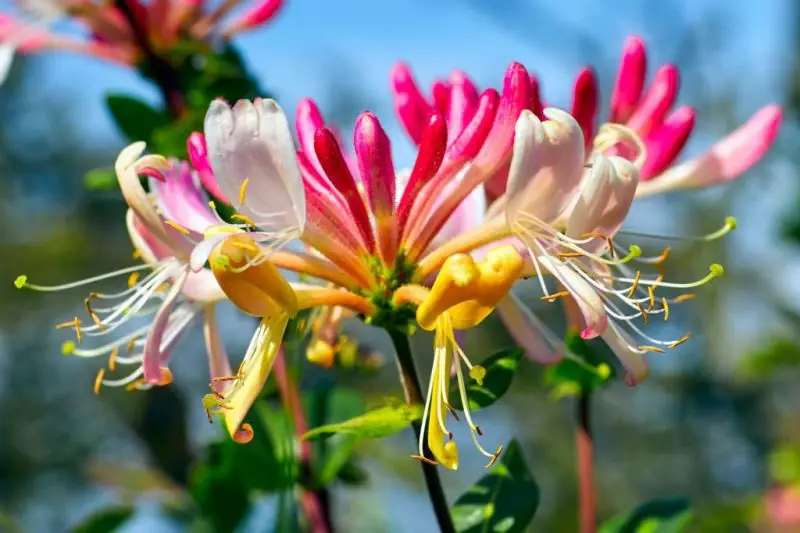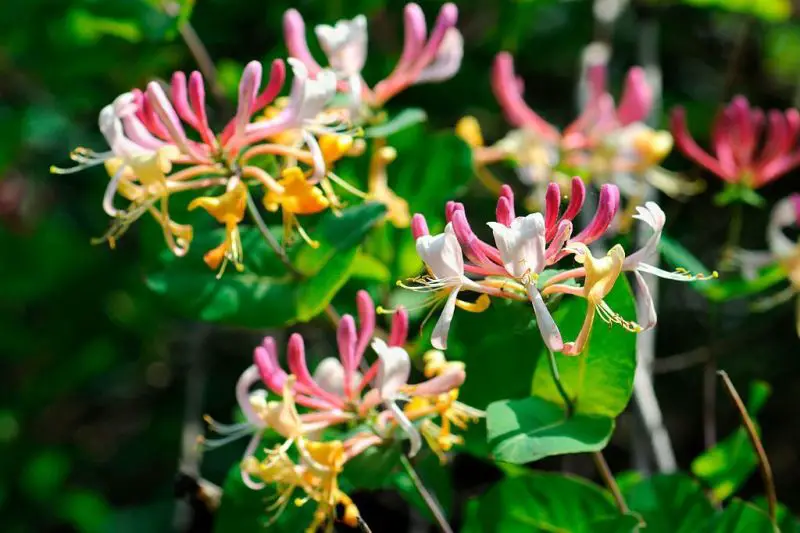Honeysuckle is a beautiful plant that smells so sweet it’s hard to resist. It’s one of the first flowers to bloom and a beautiful addition to any garden.
The name “honeysuckle” is actually a general term for several different species of woody vines. While some honeysuckles are small shrubs (Lonicera sempervirens), others can grow into thorny bushes or even trees (Lonicera flava). Regardless of their size, all honeysuckles flower early in spring before leaves bud out on the plant
The problem is that some honeysuckle plants are just not blooming. If this happens to you, don’t worry! There are several things you can do to get your plant back on track so it will start producing those sweet blooms again.
Let’s dive deep into why honeysuckle is not flowering!
Pruning at the wrong time
Pruning at the wrong time is the number one reason your honeysuckle isn’t flowering.
Honeysuckle is a deciduous shrub, meaning it loses its leaves in winter, and it blooms in spring. If you prune your honeysuckle at any other time of year, you’ll be removing buds for flowers and/or growth that will appear later in the season. The correct time to prune your honeysuckle is immediately after it has finished flowering or just before it starts to bloom again.
You should also avoid cutting off too much of the plant’s stem at once. This can shock the honeysuckle and result in delayed flowering or no blooms at all.
Planting in the shade
Honeysuckle is one of the most popular flowering vines or shrub that has fragrant white or lavender blooms in spring and summer.
Despite its popularity, many people don’t know that honeysuckle needs plenty of sun to grow well and flower. In fact, most varieties require at least 6 hours of direct sunlight each day. So if you want your honeysuckle vine to thrive and produce beautiful flowers you need to plant it where it will get this much light each day!
Honeysuckles prefer a location that gets about six hours of direct sun every day and some partial shade during the rest of the day.
The amount of sunlight they get directly impacts how much color their blossoms have and how long their blooms last. If they don’t get enough light, they might not bloom at all! If your honeysuckle isn’t flowering, try moving it to a sunnier spot so that it can get more light there.
Overcrowded
Honeysuckles are very easy to grow and propagate, but they need to be given a lot of room. If you plant your honeysuckle in a container or pot, make sure that the container or pot has plenty of space for the honeysuckle to grow and spread its roots.
If you have planted your honeysuckle in the ground, make sure that there is enough space between plants so that they can grow without being crowded by each other.
Too much moist
When a honeysuckle is growing in a container or pot, it needs to be watered regularly so that the soil stays moist. If you live in an area with very high humidity, this can cause problems for your honeysuckle, because it will begin to grow mold and fungus on its leaves and stems. This can be especially problematic if you don’t notice that something is wrong until the plant has been severely damaged by the mold or fungus.
To prevent this from happening, make sure that you check your honeysuckle every day and water it only when the soil has become completely dry (usually once every three days). If you notice any signs of mold or fungus on your honeysuckle’s leaves or stems, immediately remove them from the plant and dispose of them carefully so that they don’t spread further into your garden!
Also Read: When Does Honeysuckle Bloom?
Dry Soil
Dry soil can cause honeysuckle plants to not flower. Because dry soil means that the roots of the plant are not getting enough water and nutrients.
When a plant doesn’t get enough water and nutrients, it doesn’t grow as well. And when a plant doesn’t grow as well, it doesn’t produce flowers.
They need to be kept well-watered, especially when they are young. If your honeysuckle tree is not flowering, this could be because of the lack of water it is getting.
You should water your honeysuckle once a week during the summer months and twice a month during the winter. The best time to water your honeysuckle is in the morning or evening when temperatures are cooler.
Poor soil drainage
The most likely reason your honeysuckle isn’t flowering is poor soil drainage.
If the soil around your honeysuckle is too compacted, it can’t absorb water when it rains or if you water it. The roots are then left without enough moisture to grow and bloom properly. This is a common problem for many honeysuckles, but there are some things you can do about it.
First, try digging down a few inches into the soil around your plant and see how easy it is to dig through. If you encounter a lot of resistance that means that the soil has been compacted and will need some loosening up before it can be healthy again.
You could also try adding compost or mulch around your honeysuckle’s base to help loosen up the soil, as well as add nutrients to help encourage growth and blooming.
Fixing Honeysuckle That Wont Flower
You can fix honeysuckle that won’t flower by fertilizing it in the spring, before new growth begins. Honeysuckle needs plenty of nutrients to grow and bloom, so make sure to use slow-release or water-soluble fertilizer, both of which release their nutrients over a period of time. Slow-release fertilizers are best for plants that need less frequent feeding, these should be applied once every six months. Water-soluble fertilizers are great for plants that need more frequent feeding; these should be applied every two weeks during the growing season (this varies depending on what type of fertilizer you use).
Fertilizer should contain high amounts of nitrogen because this is one of the key elements necessary for lush flowers and leaves.
Getting Honeysuckle to Bloom on Old Plants
If you are trying to get your honeysuckle to bloom on old plants, there are several things you can do. The first thing is pruning them properly. Honeysuckle needs to be pruned every year to keep it healthy and flowering. The best time of year to do this is in the winter while they are still dormant. By winter, any dead wood should have fallen off naturally, so you don’t have anything holding up new growth or flowers if you wait until then!
The next thing that may help keep your plant blooming is fertilization every two weeks with a balanced fertilizer such as 10-10-10 or 20-20-20 throughout the summer months when the plants are growing vigorously from early June through mid September (in California).
Watering regularly will help ensure that your honeysuckle stays green and healthy all summer long! If possible try not only keeping them moist but also slightly watered down at least once each week during their active growing season here in Southern California (late February through late October). This will help prevent drought stress which can cause poor flower production later on down the road if not taken care of now!
FAQS
How do I plant a honeysuckle?
The best way to plant a honeysuckle is to dig a hole that is twice as wide as the root ball and deep enough so that the root ball is slightly below ground level. Mix in some fertilizer with the soil before filling in the hole, then place your plant into its new home and pack down the dirt around its roots. Water it well after planting, but be careful not to overwater it you should only water when the top inch of soil feels dry. This will encourage deeper roots growth, which will help keep your plant healthy over time.
What type of soil should I use for my honeysuckle?
Honeysuckles do not require much care, but they do require rich soil. You can mix your own soil by combining compost and peat moss, or you can buy a special mix at the nursery.
How do I propagate honeysuckle?
You can propagate honeysuckle by using cuttings from stems with healthy buds on them. You can also take seeds from fruit pods and grow them indoors before planting them outside later on down the line when they’re big enough.
How do I care for my honeysuckle plant?
Honeysuckles grow best when planted in well-drained soil that has been amended with composted manure or fertilizer. It needs plenty of sun and water to thrive. They also need soil that is acidic, which most soils are not. So if you’re growing your honeysuckle in your garden, you may need to add some compost or peat moss to the soil to help it become more acidic. The key is to make sure your soil pH is between 5.5 and 6.0.
If you’re planting a honeysuckle in a pot, try adding sand or pine bark mulch to the soil to help keep it moist and acidic. If you live in a warmer climate, consider placing your honeysuckle in full sun during the day and partial shade during the night this will help it stay cool.[su_youtube url=”https://www.youtube.com/watch?v=2ouV4tnAETU” width=”500″ height=”360″]
Conclusion
Honeysuckle is one of the easiest plants to grow. It’s also one of the most beautiful, and if you have a garden or even just a patch of ground in your yard, it’s definitely worth giving it a try.
We hope you enjoyed learning about the reasons why honeysuckle might not be flowering. If you have any questions, feel free to reach out!
Thanks for reading 🙂
